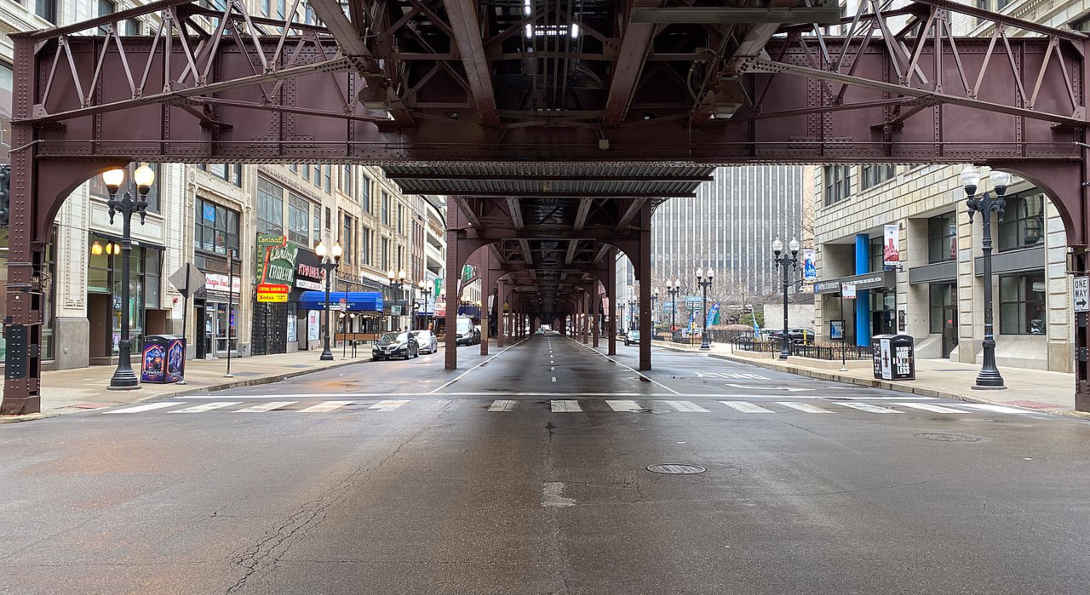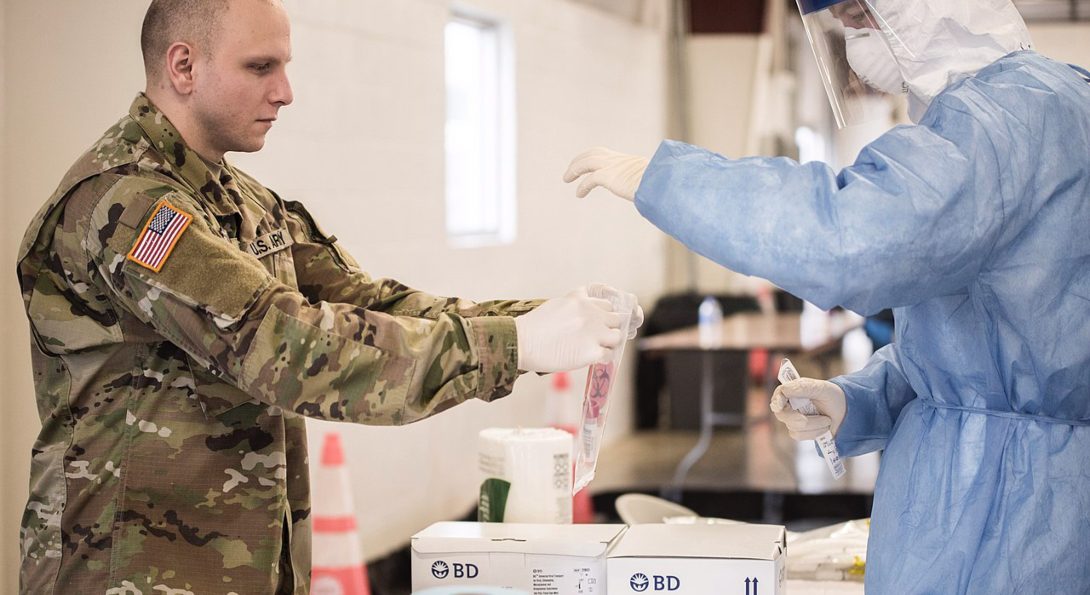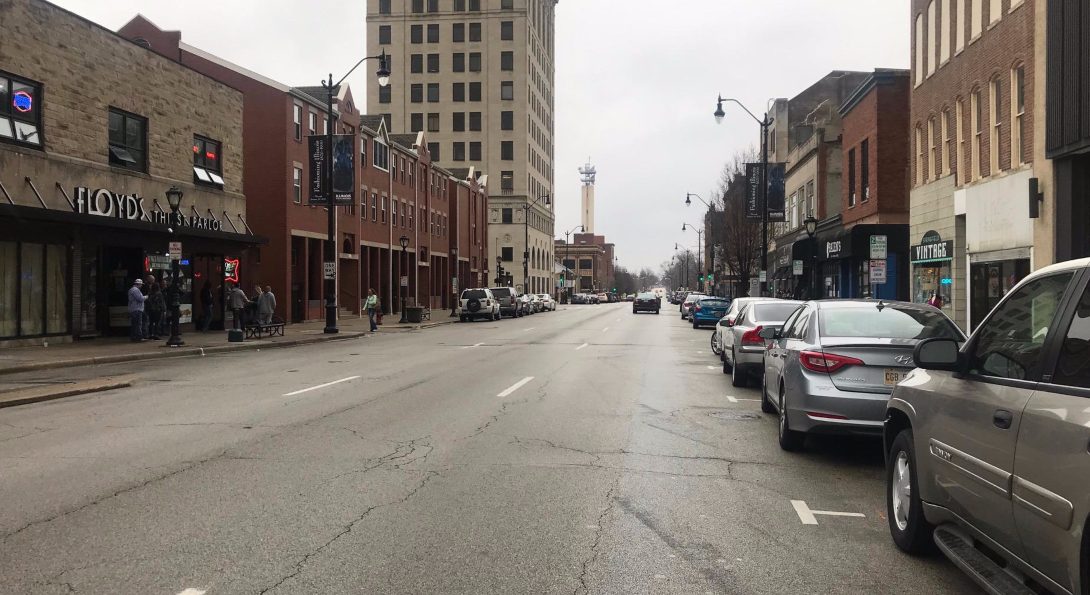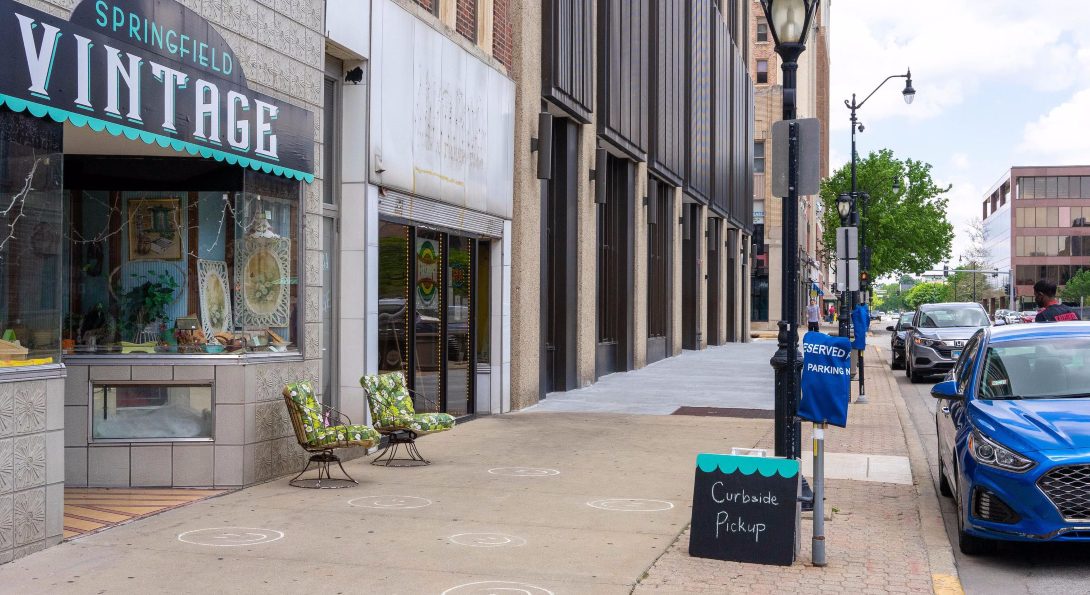The Pandemic on Main Street

As state restrictions relax, local leaders face tough choices
Tomorrow marks the end of Gov. J.B. Pritzker’s stay-at-home order, put in place to stop the spread of the deadly new coronavirus disease known as COVID-19.
People all across the state have made sacrifices, large and small, to beat back the pandemic and set the stage for what life will look like after Illinois can return to some sense of normalcy.
Gov. J.B. Pritzker unveiled a plan earlier this month that takes a regional approach, based on public health benchmarks, and includes five phases of easing restrictions.
All of the regions identified in the plan are on track to move to the next phase of reopening, Phase 3, after the current executive order expires. Under Phase 3, non-essential businesses could bring employees back, although the plan continues to encourage telework whenever possible. Salons and barbershops would be able to open under guidelines from the Illinois Department of Public Health. Restaurants would be able to have limited, outdoor dining. All gatherings of 10 people or fewer would again be allowed.
When restrictions loosen at the state level, more decisions will fall to people, institutions and government officials at the local level.
Chicago has announced its own strategy that largely dovetails with the state’s plan. However, Chicago Mayor Lori Lightfoot says the city will move more gradually, and she does not plan to roll back some restrictions until early June.
A few officials in other jurisdictions have veered in the opposite direction, declaring that they will not enforce restrictions or mandated business closures.
As the pandemic grinds into the summer, mayors, city managers, county board members, educators, faith leaders, business owners and others will be called upon to make choices they likely never contemplated before— with radically incomplete information.
Yet, most of these decision-makers do not have access to the teams of advisors available to governors, mayors of large cities, and even the leaders of major university systems like the University of Illinois, to help them navigate this new reality. With that in mind, Institute of Government and Public Affairs (IGPA) scholars, including Sage Kim, PhD, associate professor of health policy and administration, offer these guideposts for decision-makers to keep in mind as they tackle the difficult work ahead.
Using public health data

Public health data is the foundation for optimal decision-making — it can help determine when leaders can ease restrictions, and it can help monitor progress as they do so. At present, this data is limited and incomplete.
The promising strategy to “test, trace and treat” will entail increasing the number of COVID-19 tests performed each day and adding legions of workers to trace the recent contacts of infected people. The state is working to put such processes in place statewide.
Absolute assurance that any release of present restrictions does not land Illinois right back where it started — facing a runaway virus — requires either a vaccine or testing on a scale our state does not yet have.
A new analysis from Harvard’s Global Health Institute found that most states lag on the number of tests needed to safely phase out social distancing measures. As of May 15, Illinois needed to conduct more than 64,000 tests a day to be on track under the model. On May 15, Pritzker announced an expansion of testing and continued expansion plans for the coming weeks. But the state also averaged around 20,000 tests a day that week, well below what the Harvard study says is needed.
Only nine states meet or exceed the minimum level of testing called for in the Harvard analysis. They generally have fewer residents spread across significant landmass: Alaska, Hawaii, Montana, North Dakota, Oregon, Tennessee, Utah, West Virginia and Wyoming.
Without widespread testing, we lack a reliable picture of the virus’ true spread in the population, a way to know for certain whether the virus is increasing or not as restrictions relax, and even an effective containment strategy. Building this testing capacity is essential.
This means that for the near term, decision-makers will face choices based on less-than-perfect information. The question then becomes how to move cautiously and responsibly as the state works to build testing capacity and refine public health measures.
Understanding social and economic harm

Illinoisans have lost family members. Many have died in hospitals alone. Yet, the human toll of the pandemic includes more than lives lost. It includes other health effects, such as delayed surgeries and reduced access to primary and behavioral healthcare. Lost jobs have led to lost health insurance, lost wages and food insecurity. Staying at home has created the potential for increased incidents of partner and child abuse. Sheltering in place has led to feelings of hopelessness and isolation. It has frayed emotions and relationships.
A clearer picture of the economic toll of the pandemic is starting to take shape. Illinois has had more than 1 million unemployment claims since March 1, and more than twice that number of jobs are considered at risk for layoffs, furloughs or drastic reductions in hours, according to projections from McKinsey Global Institute. The U of I Flash Index, which provides a monthly reading of the state’s economy by measuring growth rates in corporate earnings, consumer spending and personal income, saw the sharpest two-month decline in March and April in the index’s history.
Economic indicators shed light on the some of the fallout from the pandemic, but the social and emotional costs are harder to document.
More than half of respondents to a nationwide survey conducted by The Kaiser Family Foundation said they were worried about losing their jobs, and nearly half said that concerns about the COVID-19 pandemic were affecting their mental health.
A recent report from the Well Being Trust and the Robert Graham Center highlights an “epidemic within the pandemic” in the form of deaths of despair — suicides and deaths from substance use disorders. The report looks at nine possible scenarios that contemplate different timelines for recovery and varying intensity of lost jobs. The projected number of U.S. deaths of despair linked to the economic pain and social and mental distress caused by the pandemic range from 27,644 under a quick recovery to 154,037 under the most extreme scenario.
These projections make clear that a holistic understanding of the pandemic’s human toll in Illinois is a critically lacking piece of the puzzle about reopening the state’s economy. Local officials are perhaps uniquely attuned to this pain because their constituents are their neighbors. But also, many others are likely to be struggling quietly, especially the most vulnerable who might not have access to virtual channels of communication.
IGPA is constructing a series of four Pandemic Stress Indicators to help measure the human toll. One will ask three sets of experts — public health experts, economists and vulnerability scholars — about how and when the state should move through the phases of reopening. These groups will be polled on a weekly basis. A second indicator will draw directly from regularly scheduled interviews with leaders of affected vulnerable communities, especially communities of color.
A third indicator will draw on the experiences of ordinary individuals from all over Illinois, who will document their lives through videos and journals uploaded with their cell phones. A fourth indicator will regularly assess what Illinois residents think directly, using a focus group that includes respondents from vulnerable populations.
Illinois needs to grasp this suffering in a more comprehensive way, to help inform when and how each region can begin to move back to normalcy. Having a deeper awareness of the challenges people are facing can help to identify shared problems across regions and allow for statewide or cooperative policy solutions. If residents in one area are facing challenges that have been addressed in another part of the state, local officials could swap notes on solutions and benefit from each other’s innovation and best practices.
Building a fuller understanding of people’s suffering is not an argument for being oblivious to public health concerns — public health tools are necessary to monitor progress in the fight against COVID-19 and react accordingly. Decisions about opening the economy will be better for considering the economic and social impacts on individuals, as well.
Minimizing total harm

Slowing the spread of the virus has been the primary focus thus far in Illinois. As the state moves through its reopening phases, there is a risk that virus transmission rates will increase. Managing the tradeoff between resuming some normal activities versus the potential risk the virus takes off is the key challenge facing policymakers.
Illinois policies should aim to minimize the total harm, while safeguarding vulnerable persons and respecting civil liberties. Minimizing total harm is the thrust of many government policies.
Consider why governments set speed limits. If their sole priority were to prevent road deaths, officials could enact a total travel ban, thereby minimizing motor vehicle fatalities.
A laissez-faire model might instead allow people to drive as fast as they wish because it maximizes personal enjoyment and business output of long-haul truckers. A “minimize total harm” model recognizes that the choice of speed limit needs to balance the risk of motor vehicle accidents and fatalities against the convenience of speedier travel and the joy of driving fast.
While working to minimize total harm, officials must add guardrails to ensure that the harm and benefits of policy decisions are shared as fairly as possible by all Illinoisans.
One guardrail around decisions should be that identifiable groups who came to the pandemic vulnerable to the virus or the economic fallout should not bear a disproportionate share of the costs of containing the coronavirus or repairing the economy.
The choice of whether or how to reopen restaurants is an example of how this consideration might play out in a decision-making process. Keeping restaurants closed may pass a minimize-total-harm test. But much of the economic cost of that approach would be borne by restaurant workers and owners, while the benefits of the reduced risk of general virus transmission will be dispersed widely throughout the population.
One approach responsive to this guardrail is to not permit restaurants to reopen but to provide financial compensation to restaurant workers. Alternatively, policymakers could allow more commerce to resume in this sector, but with temporary regulations aimed at bringing transmission risk down.
Different decisions will affect different populations and economic sectors in varying ways. Some Illinois residents have been hit with a double whammy: they are vulnerable both to the virus itself and to the economic fallout. An analysis of U.S. Bureau of Labor Statistics from the Economic Policy Institute found that African American and Latino workers are much less likely to have jobs that allow them to work from home. Under the current conditions, these individuals are bearing more risk — either to being infected while at work or to economic hardship from losing their jobs. In Illinois and across the nation, African American and Latino populations have been disproportionately affected by the virus.
A singular emphasis on avoiding impacts on identifiable groups could paralyze decision-making, but, nonetheless, policymakers should try to mitigate impacts where possible.
A second set of guardrails around decisions must be in place to safeguard civil liberties. For instance, the right to be safe is one of the most basic human rights, yet reporting of child abuse and neglect have plummeted since people have sheltered in place.
One unintended consequence of the distancing restrictions may be that abuse cases are going unreported. A recent IGPA Policy Spotlight on this subject offers concrete steps that state and local officials could take now. One such step is to provide essential workers who may interact with children, like grocery store workers, information on the warning signs of abuse and how to report suspected cases.
Efforts at contact tracing, limits on assembly and restrictions on religious observance, if out of proportion, could also raise issues around liberty. GPS and cellphone technologies have been used in other countries to facilitate tracing which is essential to containment efforts. But these same technologies can enable surveillance of the entire population, implicating privacy.
Wearing masks has been identified by public health officials as a way to reduce the risk that those who are infected, but are unaware that they are sick, will transmit the virus. Gov. Pritzker’s most recent stay-at-home order includes a requirement that residents wear masks when they are in settings that make social distancing difficult.
The mask requirement has become a flash point over civil liberties, with some opponents arguing that it violates their rights.
The ACLU of Illinois believes that the governor’s order to wear masks is enforceable. However, the ACLU warned against another potential implication for civil liberties associated with mask wearing: the possibility that police will profile people who are wearing masks and other face coverings.
This concern played out publicly in Illinois after state Representative Kam Buckner related his experience of being stopped by a police officer while he was leaving a store in Chicago. Buckner, who is African American, said when he asked why he was stopped, the officer responded that he couldn’t see Buckner’s face and thought he looked like he was “up to something.” Other African-American men across the country have reported similar interactions or fears that wearing a face covering would put them at risk.
All residents must be able to protect themselves and others from the virus without facing discriminatory policing. Local law enforcement officials can regularly emphasize that adjusting to the new normal means residents will be wearing face coverings — and profiling will not be tolerated.
Proceeding with caution, learning from others
The pandemic ravaged other countries and other U.S. states before it gained a toehold in Illinois. Those nations and states are reopening before Illinois — in some cases before they have “flattened the curve.”
As time passes, they will produce desperately needed data points. When the health data and assessment of how best to minimize total harm signals that it is time for Illinois to start opening its economy, Illinois will be able to draw on the rapidly unfolding experience of like-situated countries and states to make better-informed decisions. Not going first makes Illinois’ decisions less a leap of faith and more an exercise in informed risk taking.
Making policy that is mindful of ensuring health and minimizing pain, while not sacrificing equity and basic individual rights and liberties, will be difficult. These hard decisions will require weighing the value of worthy goals that sometimes will be in conflict.
If the desire to “return to normal” becomes too great too soon, Illinois may misstep. But we can also misstep if in battling for our collective health, we lose sight of the end goal of promoting human flourishing.
Not all the harm that flows from decisions can be avoided. Not all our collective pain can be shared equally. But a clear understanding of the burdens borne by Illinoisans must be the foundation for restoring the lives that have been and will be damaged as communities work to combat the coronavirus.
About the authors
Sage Kim, PhD, is an associate professor of health policy and administration at the University of Illinois at Chicago (UIC) School of Public Health.
Co-authors include: Robin Fretwell Wilson, Director of the University of Illinois System’s Institute of Government and Public Affairs; Don Fullerton, IGPA Senior Scholar and Gutgsell Professor of Finance at the University of Illinois at Urbana-Champaign; Brian Gaines, IGPA Senior Scholar and Professor of Political Science at the University of Illinois at Urbana-Champaign; J. Fred Giertz, IGPA Scholar Emeritus and Professor Emeritus of Economics at the University of Illinois at Urbana-Champaign; Kent Redfield, IGPA Scholar Emeritus and Professor Emeritus of Political Science at the University of Illinois at Springfield,; and Julian Reif, IGPA Senior Scholar and Assistant Professor of Finance and Economics in the Gies College of Business at the University of Illinois at Urbana-Champaign.